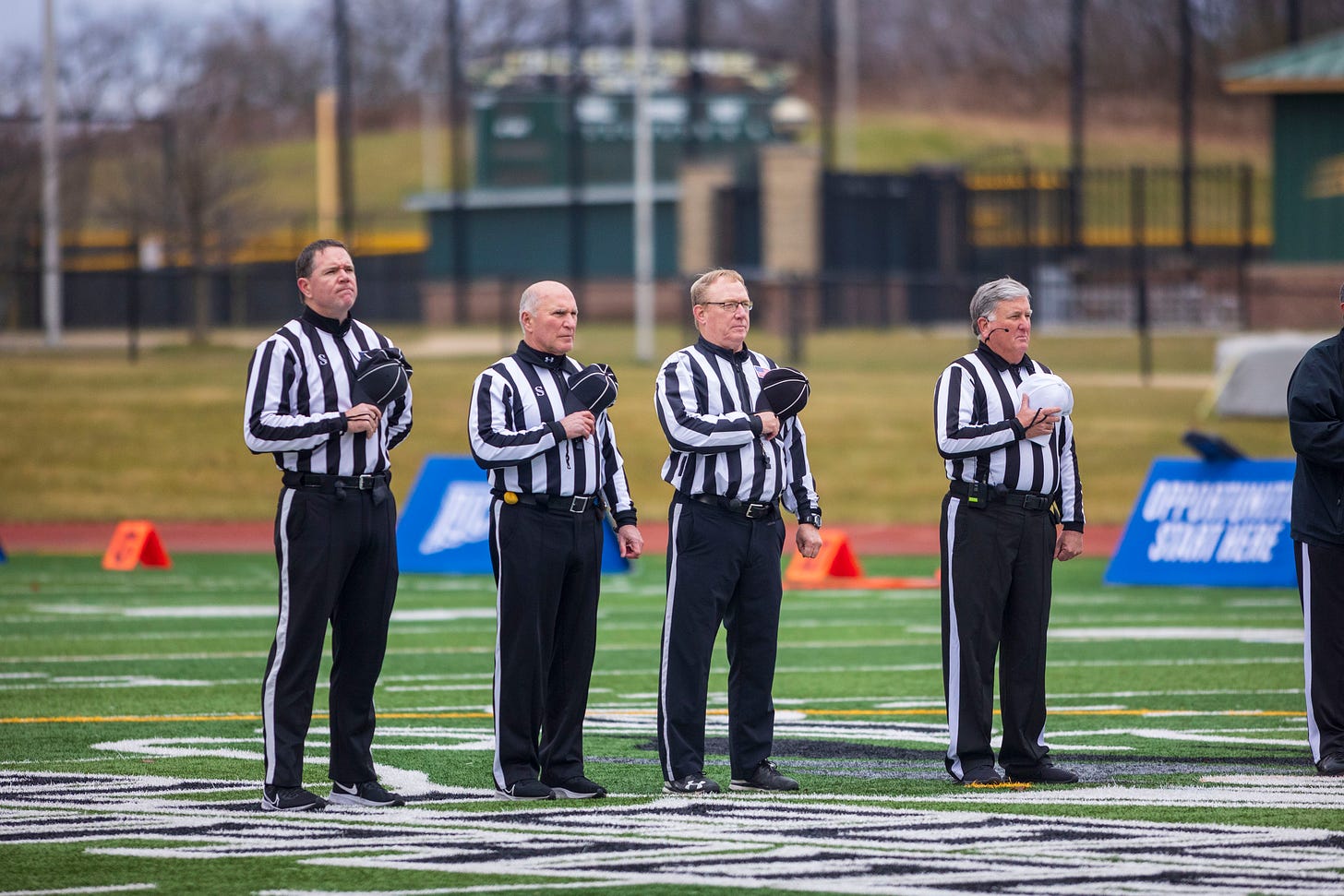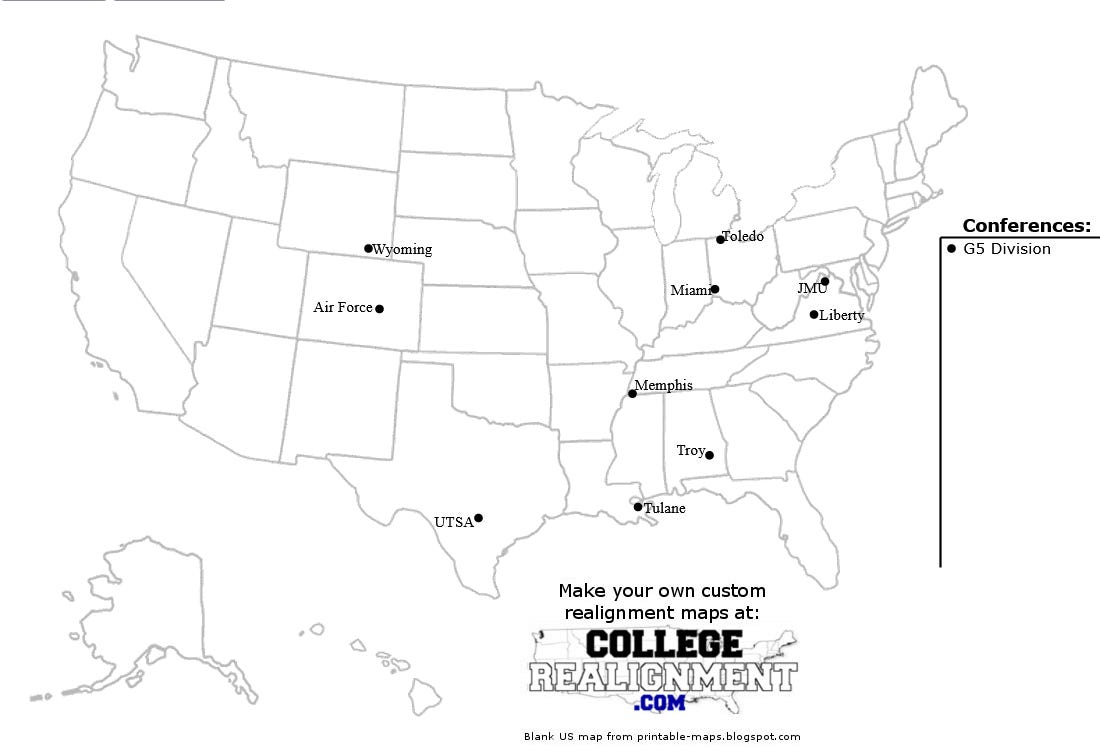
It’s no secret that top college athletics brass aren’t fans of the NCAA. There’s plenty of articles across the internet, including here at SID Sports, that go over the various legal issues plaguing the college athletics governing body.
The idea of a college football “Super League” is also no secret. In fact, it’s the fear of many college football fans. Most often, it’s the idea that the nation’s two most powerful brands - the Big 10 Conference and Southeastern Conference - would split off from the NCAA and start their own league. But that’s always been a pipe dream, oftentimes used to create the impression that the soul of college sports has eroded and the sport will be destroyed in one aggressive money grab.
Now, though, we’re staring this far-off concept in the face. It’s becoming reality. An actual Super League proposal is on the table and boy does it carry some weight.
What even is this proposal?
The new Super League proposal comes from an outside group: College Sports Tomorrow.
Who?
Well, this is where it gets interesting - and some legs. College Sports Tomorrow is a 20-person committee that includes executives across the sports landscape, including luminaries such as Philadelphia 76ers owner David Blitzer, the NFL’s number two man Brian Rolapp, Len Perna of TurnkeyZRG, a search firm that lands many top conference commissioners, and two sitting NCAA presidents: West Virginia’s Gordon Gee and Syracuse’s Kent Syverud.
Obviously, this is a star-studded group that carries a ton of power not only in college sports, but in the entire sports world. If they feel so strongly about this as to lay down a proposal, then they mean business.
But let’s get into the proposal’s meat-and-potatoes, shall we?
The main change is to, obviously, create a Super League at the top of the college athletics Pantheon. To do this, the FBS in its entirety would split off from the NCAA and become its own governing body. Not too bad, right? Buckle up, it’s about to get real funky.
In this new Super League, the top 70 teams would get a permanent seat at the Top Division’s table. This, predictably, includes the 68 Power Five teams (including the PAC-2’s Oregon State and Washington State), Notre Dame, and incoming ACC member SMU. That 70 team block would be then divided into seven 10-team divisions (read: conferences) based on geography and rivalry history.
That’s right folks, we’re going to be so new, we’re back to the old way of having regional conferences! Isn’t that great?!
But what about the Group of Five schools? Are they just thrown to the wayside like the FCS teams were when Division I split? Not entirely. There would be an eighth 10-team division made up of the top 10 teams from the remaining 50 or so programs. This final division will not be made up with any geographic sense. Instead, it’s a promotion-relegation system modeling European football (soccer) leagues.
So how does this work with the postseason’s College Football Playoff? Again, we turn to the NFL for inspiration. Only the top tier would have a shot at the national championship, and it’s unclear if bowl games still factor into this proposal. But, the format is simple: the eight division winners get automatic bids, and the rest of the field is filled out by eight wild card programs. Wild card teams are determined by an NFL system of win-loss records and tiebreakers, such as head-to-head results and others used in professional sports.
What are the benefits of this?
Well, for one, it simplifies a ton for the schools. Well, kinda.
Essentially, this proposal would put the entirety of the FBS under one negotiating umbrella - the Super League. The League would then negotiate media deals and manage the governance of the league, it’s teams, rules, regulations, and players. This means that conference rules would be simplified. No more would postseason arguments be determined by the SEC’s eight-game conference schedule versus the Big 10’s nine-game slate.
They also floated the idea of an MLS-style ownership system, where universities with programs in the league would receive an ownership stake in the joint effort. This is similar to how conferences operate, where university athletic directors, chancellors and presidents
It also allows for a clean slate when it comes to NIL, the transfer portal, and other rules. Where the NCAA is dragging it’s feet on instituting new rules and instead waiting for either litigation or legislation to force their hand, this new non-NCAA-affiliated league could make their own rulings. We’ve seen plenty of ire directed at the NCAA, especially in cases like Tez Walker’s transfer this fall. This could be an appealing option for the university athletic departments to start fresh.
Finally, and most exciting for fans, this will improve the level of play for the nation’s top teams. Regional conferences return, and we likely won’t see as many body bag games. Instead, powers will schedule powers in order to vie for the postseason. Plus, having a division championship autobid makes more risky out-of-conference scheduling pay off if you’re hunting for a wild card bid.
What are the drawbacks?
For one, the CST is clear that there would be an “uneven revenue distribution,” among all teams, even including the top tier. We can assume that this distribution would be determined by postseason bids, viewership, and other successes that are measurable, but the CST didn’t go into details.
I’m also concerned by the second-tier teams. While having a revolving door division for the top G5 programs, that could be a travel nightmare. If we use the final AP Poll following last season’s national championship, that division would include:
Liberty (Lynchburg, VA)
Tulane (New Orleans, LA)
James Madison (Blacksburg, VA)
Memphis (Memphis, TN)
Troy (Troy, AL)
Air Force (Colorado Springs, CO)
Toledo (Toledo, OH)
Miami (OH) (Oxford, OH)
UTSA (San Antonio, TX)
Wyoming (Laramie, WY)
That’s a conference that spans eight states for teams that likely aren’t at the top of the revenue distribution chain. It could put severe strain on those smaller schools’ budgets, especially since most play in already regional conferences like the Sun Belt or Mid-American.
I don’t want to pull the “College Football Traditionalist that’s afraid of change” card, but this will also eliminate a lot of the pageantry that makes college sports special. Realignment has vastly changed the landscape of college athletics, but it’s uniquely college. Bowl games, which are also uniquely college, would also go to the wayside. And forget about another Appalachian State upset over Michigan. It just won’t happen under this new model.
Further Reading:
How did we even get to this point?
This is a culmination in a ton of strife among the NCAA and its member institutions, and I feel like a clean break from the upper echelon of schools is certainly looming unless the NCAA bends its knee to the autonomy conferences.
It’s clear that the main driving factor for this conversation is the looming case of House v. NCAA, an antitrust suit that is seeking $4 billion in damages for student-athletes who played prior to NIL laws taking effect. Couple that with the Dartmouth NLRB decision that ruled that Dartmouth men’s basketball players are employees, and it’s easy to see that traction is gaining that universities will have to start paying athletes. The NCAA itself even floated the idea of direct-to-athlete compensation models in December.
Even with that, we haven’t scratched the surface of the ugliness brewing between universities, the NCAA, and state governments. Following the news that the NCAA was investigating NIL-related recruiting practices at the University of Tennessee, the state of Tennessee and commonwealth of Virginia filed a joint lawsuit against the NCAA. In February, a U.S. District Court issued a preliminary injunction in the case that prohibits the NCAA from enforcing any NIL-related policies.
State governments have also taken aim at transfer portal rules, with seven states alongside the Department of Justice challenging the NCAA’s portal rules. There are other cases pending, such as Hubbard v. NCAA, which is seeking back-paid Alston stipends for current and former Division I athletes, another NLRB case raised by USC, a lawsuit lobbied against the NCAA by a former Villanova football player alleging minimum wage violations, and an antitrust case filed in California that seeks to eliminate any restrictions on athlete compensation. No ruling is in that case, but I’m sure you get the picture. Things are bad for the NCAA, and it may be irreparable at this point.
The big question: Does this proposal matter?
Yes, clearly this proposal matters. But the real question is will it be implemented?
As with any proposal, there’s a long way to go. This would be a monumental change, and a lot of people have to sign on for this to even be seriously considered.
The first hurdle this faces is that the conferences would likely have to agree. They’d still exist, but their membership would be dramatically altered. According to The Athletic’s Stewart Mandel and Andrew Marchand, so far only the ACC has heard a presentation from CST. Planned meetings with the Big 10, Big 12 and SEC have all been cancelled. Without the big brands in those conferences, this proposal is dead in the water.
Additionally, each and every conference currently has its own media deal that is dependent on its membership - even Notre Dame has their own media deal with NBC. Most of these deals run through 2030, which limits this proposal greatly.
Finally, and the least obvious, is that the CST’s Super League idea opens up the organization to a host of legal issues. Buying out media deals is one thing, but a new slew of antitrust suits is another. Just look at the landmark 1984 NCAA v. Oklahoma Board of Regents case. This case was based on the idea that the NCAA was the sole negotiator for all member institution’s television deals. At the time, the NCAA would limit the amount of TV exposure for teams in order to not affect in-stadium attendance. Understandably, the schools knew they were worth more with a full television package, but the NCAA would not budge. So, the University of Oklahoma’s Board of Regents sued the NCAA, stating that their television rules and restrictions were an antitrust violation under the Sherman Act. They won, as the Supreme Court ruled 7-2 in favor of the Board of Regents, saying the NCAA’s television policy was restricting the free market.
Now, the CST isn’t going to limit the amount of televised games for each team. But, as a single entity negotiating with each media network, they control where the games would be televised. It’s easy to imagine the schedule moved around so the big draws - Ohio State, Michigan, Alabama, Texas, Notre Dame, etc. - dominate the airwaves while the leftovers are flung onto Peacock, ESPN+, Apple TV, or maybe even The CW. It doesn’t take a big leap of the imagination to see member schools quickly growing tired of that.
With all that said, the CST Super League idea is interesting on the surface, but falls apart under scrutiny. It’s a fun idea - one that I might plug into my next NCAA Football dynasty until the new game comes out - but isn’t one based in reality. Sure, it makes things like NIL and direct compensation easier, but it presents a whole new host of problems that schools likely won’t want to get involved in.
Have any questions, ideas, article pitches, or information? With the new Substack features, you can directly message me! Hit the button below to send me a message, or reach out via email to sidsports23@gmail.com, or find us on your favorite social media platform like Facebook, Instagram, Twitter, Substack Notes and Bluesky.









